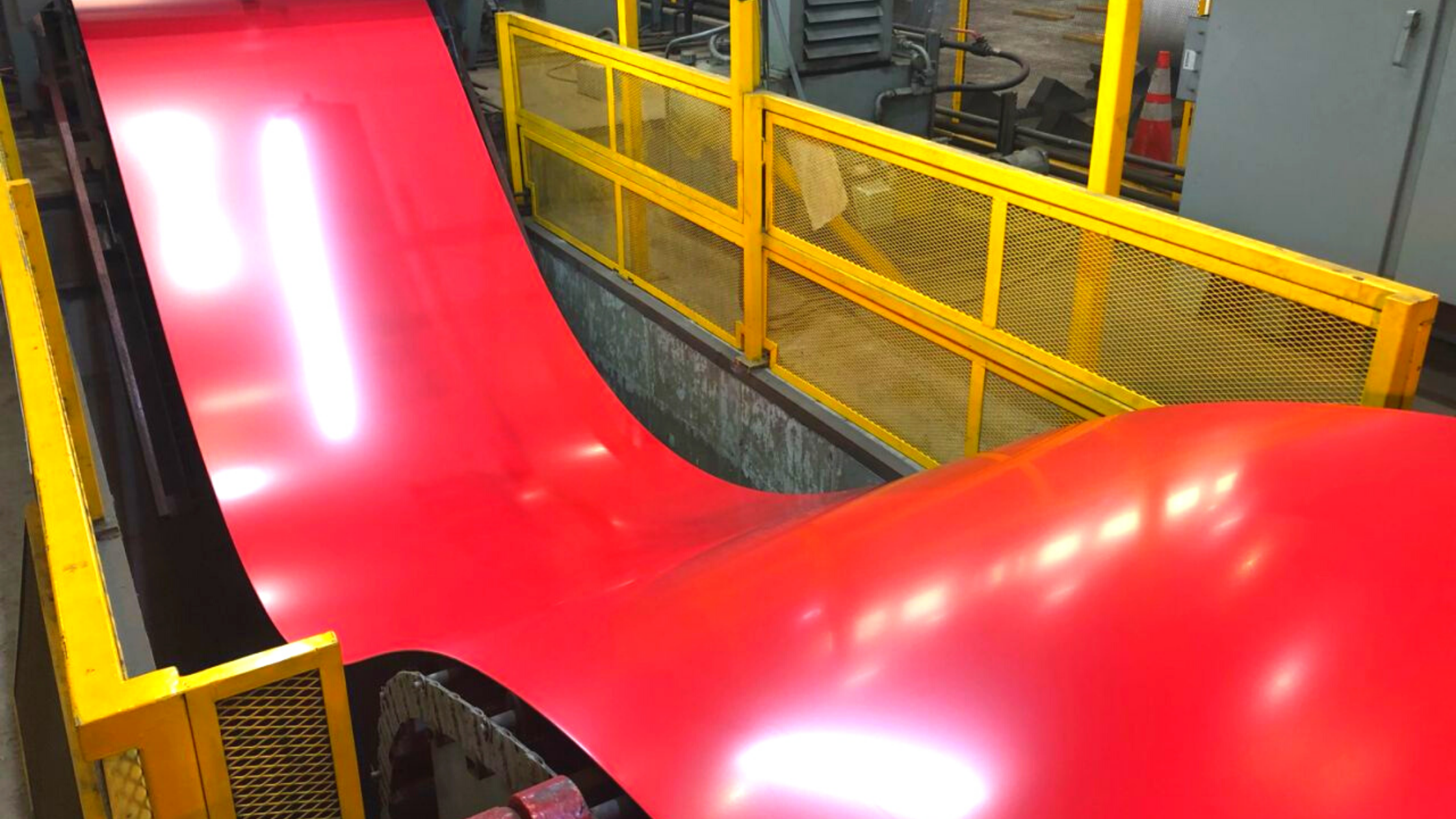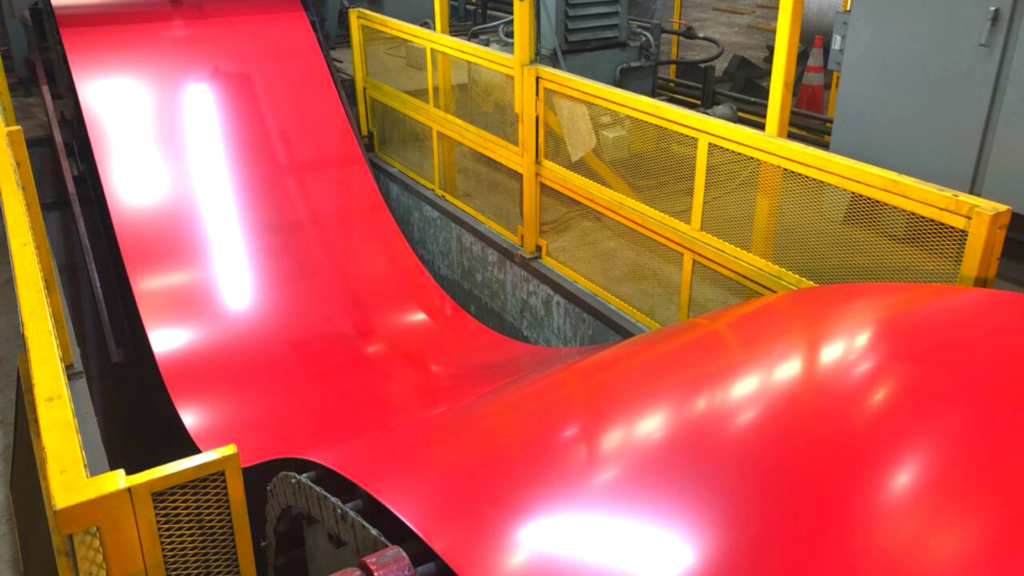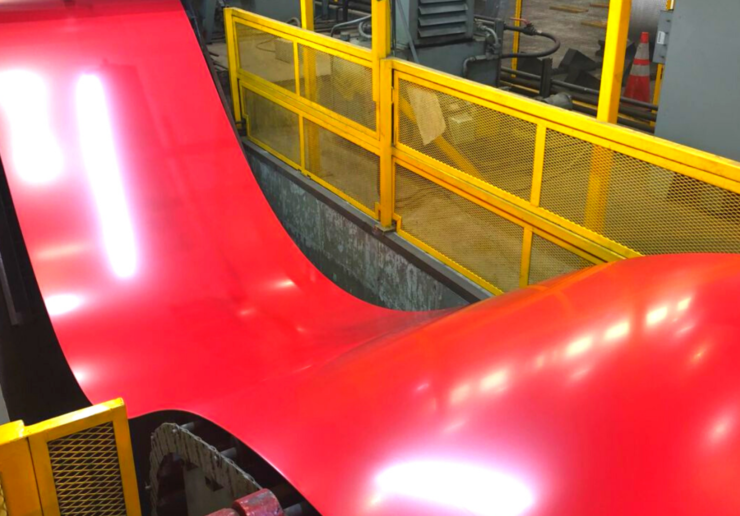
Coil coating refers to the process of creating prepainted steel and aluminum. Prepainted steel or aluminum can be found in a high number of household products. From refrigerators to air conditioners and construction material, prepainted steel can be found everywhere. Different coatings can be applied for different demands.
“In some coatings, you are going to need more exterior environment weathering, flexibility, and more impact resistance than you do with other coatings,” says Aaron Small, Corporate Vice President at Kloeckner Metals U.S. and President of the National Coil Coating Association (NCCA). “If we’re going to do roofing and sidewalls, we would often choose either a fluorocarbon, siliconized polyester, or modified polyesters.”
Coil coating is how the coating material is applied to the strip of steel or aluminum. A coil of metal sheet is continuously fed into the process which is controlled via accumulators at each end of the line. They take in a bare coil of metal at one end and let out the finished product on the other end. In the middle, the coil coating process is applied.
“What we do is actually referred to as high-speed, continuous coil coating,” Small says. “What makes high-speed, continuous coil coating possible is the non-stop application of the cleaning, the treating, the coating, the curing, and potentially the leveling, while the sheet is flat, all in one high-speed path through a coil coating line.”
The key is being able to maintain a constant speed of the strip through the process. The accumulators allow this by letting the middle of the line to continue running at the prescribed rate while new metal is added at the decoil end, or the finished product is removed from the recoil end of the line.
“You don’t have starts and stops,” Small says. “This allows our coaters to consistently clean, treat, seal, apply a paper-thin coating, cure it evenly, and cool it back down without burning the metal or the coating.”

Coil coating has evolved significantly since the process was first developed in the 1930s, but then it was not a high speed or continuous operation like we have today. One of the first major uses of coil coated materials was the coating of emissions lines. In the 1950s and 60s it began to see greater and more widespread use.
“It started with very narrow aluminum coils and paint that would be poured in by hand out of a one or five-gallon bucket,” Small says. “These coils were really tiny. A lot of times a single man could pick up the coil and put it on the coiling line.”
With the development of the accumulator towers, the process was fully industrialized. In the 1970s and 1980s, it was not uncommon for a single system to run continuously for an entire week. Today, some lines run up to 1000 feet per minute.
“That made it a very cost-efficient way to paint metal,” Small says.
The key element of prepainted steel is that the product is cleaned and treated while in a flat state. You don’t have any nooks or crannies, as you do with an already formed metal for surface impurities to hide and hinder adhesion which is ultimately important for film integrity and corrosion resistance. Both the top and bottom of the metal are thoroughly cleaned and treated, which greatly improves the adhesion of the coatings. When one of the prime attributes of high-speed coil coated metal is its ability to be formed after coating. You can’t reach that potential without great adhesion.
You can then form the metal into a variety of uses. Numerous household appliances, including refrigerators, air conditioners, dryers, and hot water heaters, use some form of prepainted steel or aluminum in their construction. The automotive industry also utilizes prepainted steel or aluminum in their parts. A couple of large markets, metal roofs, and garage doors utilize the product, too.
Prepainted metal, even with cut edges, has been found to consistently offer more corrosion resistance than post-painted surfaces, according to a case study conducted jointly by the NCCA, PPG Industries, Inc., and the North American Zinc-Aluminum Coaters Association. In the study, prepainted metal louvers with exposed cut edges were subjected to the same environment as one with a post-painted electrocoat, a second with a powder finish, and a third with a spray finish. After 16, 44, and 68 months of exposure to the elements in Daytona Beach, Florida, the prepainted metal showed consistently better corrosion resistance in terms of the uniformity of the treatment and film thickness.
What sets prepainted steel and aluminum apart is the consistency of the product in both appearance and quality. Coating the metal in a flat state allows for incredible uniformity in the coating, and the industrial process allows for a large amount of control.
“The overall consistency of the whole operation is just fantastic,” Small says.
If you like what you are reading, feel free to check out our previous blog posts on topics such as galvalume metal roofing, enameling steel, metal service centers, PVD, and aluminum. For help with your next coil coated architectural project, call (678) 259-8800.

Steel base plates are fundamental elements employed in various manufacturing...
Metal fabrication is a critical process that transforms raw metal...
The solar industry has undergone a significant transformation by incorporating...

X
The Kloeckner Metals website uses modern technologies. Unfortunately, your browser doesn't support those technologies.
Download the latest version of one of these browsers to experience the site: